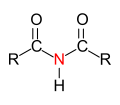Tertiary (chemistry)
The adjective tertiary (abbreviated tert .; From Latin tertiarius ) means "in third place" and is also used in chemistry as a word-forming element, e.g. B. in tertiary product and tertiary structure . The short form tert - is used as a descriptor in semi-systematic substance names, for example in tert -butanol .
Organic chemistry
|
Central atoms marked in red in various groups of substances . Comparison of tertiary with primary , secondary and quaternary central atoms. |
||||
| primary | secondary | tertiary | quaternary | |
|
Carbon atom of an organic compound |

|

|

|

|
| alcohol |

|

|

|
does not exist |
| Amine |

|

|

|
 (see QAV ) |
| Carboxamide |

|

|

|
does not exist |
| Phosphine |

|

|

|
 (see QPV ) |
In organic chemistry , the word “tertiary” is a term for the degree of substitution of three of several hydrogen atoms bound to a central atom ( carbon , nitrogen , phosphorus ) by organic radicals (organyl radical, such as alkyl radical, alkenyl radical, aryl radical , Alkylaryl radical etc.), e.g. B. tertiary alcohols contain a tertiary carbon atom (central atom = carbon), tertiary amines contain a tertiary nitrogen atom (central atom = nitrogen), tertiary phosphines contain a tertiary phosphorus atom (central atom = phosphorus).
Examples of tertiary central atoms
- a carbon atom in an alkane or an alcohol which, in addition to three substituents, also bears one or no hydrogen atom, or
- a nitrogen atom in an amine to which three organic radicals are attached.
In the case of tertiary compounds, this usually leads to a significant steric hindrance of the functional group and to the fact that typical reactions are more difficult or not at all, compared with secondary compounds of the same class of substances.
Examples of such compounds are tertiary alcohols (example: 2-methyl-2-propanol ), tertiary amines (example: triethylamine ) and tertiary phosphines (example: triphenylphosphine ). A typical example of a tertiary carbon atom is the middle carbon atom in 2-methylpropane .
Inorganic chemistry
In inorganic chemistry a term for salts that are formed by neutralizing three hydroxyl groups of a polybasic acid, e.g. B. Calcium phosphate , Ca 3 (PO 4 ) 2 .
See also
Individual evidence
- ↑ According to the IUPAC nomenclature, secondary or tertiary amides are substituted with two or three acyl groups on the nitrogen. However, since primary amides with one acyl group and two hydrocarbon substituents on the nitrogen are called "tertiary amides" in common usage, classification into primary, secondary and tertiary amides is not recommended. Entry to amides. In: Römpp Online . Georg Thieme Verlag, accessed on May 15, 2019.
- ^ Brockhaus ABC Chemie , VEB FA Brockhaus Verlag Leipzig 1965, p. 1274.
- ↑ Otto-Albrecht Neumüller (Ed.): Römpps Chemie-Lexikon. Volume 6: T-Z. 8th revised and expanded edition. Franckh'sche Verlagshandlung, Stuttgart 1988, ISBN 3-440-04516-1 , p. 4170.
- ^ Brockhaus ABC Chemie , VEB FA Brockhaus Verlag Leipzig 1965, pp. 1388f.